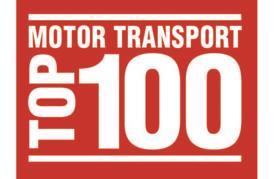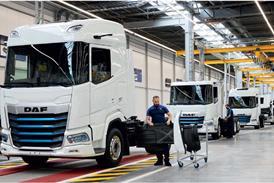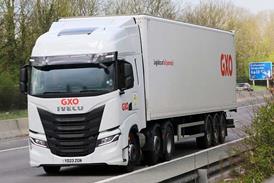The Direct Vision Standard (DVS) is being introduced by TfL on 1 March after being postponed from its original implementation date of October 2020 due to the Covid-19 pandemic.
From March, any HGV over 12 tonnes other than a few exempt specialist vehicles such as mobile cranes must either have a one star rating for driver direct vision from the cab or be fitted with an approved safe system of cameras and sensors to enter Greater London or the operator will face a fine of £550. The DVS scheme boundary matches the London Low Emission Zone (LEZ) and will be enforced by the same ANPR camera network.
Although DVS is not aimed specifically at construction vehicles, it is estimated that three quarters of N3G off-road tippers are zero star rated and these vehicles with their high cabs and limited vision - especially low down to the nearside - are in the spotlight when it comes to collisions with vulnerable road users such as cyclists and pedestrians.
After complaints from operators about delays in the application process and problems in getting safety equipment fitted, TfL has granted a grace period of 90 days to operators who are having difficulty fitting safe systems. But that grace period only applies if the operator has applied to join TfL’s ‘allow list’ by 1 March and operators must submit evidence from the fitter or garage on branded documentation with details of the fitting appointment and vehicle registration number before 1 March to DVSGracePeriod@TfL.gov.uk

Christina Calderato, TfL head of transport strategy and planning (pictured), is encouraging all operators covered by DVS to ensure they have applied for their free HGV safety permit well before the deadline. “We had issued 50,000 permits by the beginning of January and we are now up to 70,000,” Calderato told MT. “The numbers are coming in thick and fast so we are seeing those applications coming through and getting the permits out.
“When we were talking to the trade about the risk of missing the 1 March deadline, because there could be a backlog of operators wanting to get safe systems fitted, we agreed that anyone who is in the process of getting a safe system fitted, and have it booked but won’t meet the deadline, can apply to us with evidence. They will be added to an allow list and for period of up to 90 days they won’t receive an enforcement notice.”
Another source of delays is that TfL bases its star rating on vehicle data from the DVLA and only collects this data every 28 days.
“We have been working with industry on process issues to make sure things run smoothly before 1 March,” says Calderato. “We have trained additional staff and our processing time is now 10 to 28 days and Capita is turning around single-vehicle applications pretty much in a day.
“We have been working with the vehicle manufacturers so that wherever possible operators can get the information direct from the manufacturer and they don’t have to wait for the DVLA,” says Calderato. “We are also able to let people self-certify if their vehicle is zero star so if they go on the vehicle checker and it’s not found yet they can crack on with getting a safe system fitted.”
While the Covid-19 pandemic is still far from under control, DVS is part of the London mayor’s overall Vision Zero target of eliminating all deaths and serious injuries from London's transport network by 2041.
“We are still seeing high numbers of people killed and seriously injured by HGVs,” says Calderato. “So far in 2021 three people have been killed in collisions with HGVs. Despite the pandemic it is not viable for us to continue delaying safety schemes because people are still getting hurt on London’s roads.
“We have had a long pre-compliance period, we have worked with industry to make the processes better and we have the grace period, but it is absolutely critical we get the scheme in force to realise the safety benefits.
“We don’t think DVS by itself will get us to Vision Zero but it is part of a holistic policy package that also includes improving dangerous junctions, increasing the amount of protected cycle lanes and introducing 20mph zones.”
While there is little hard evidence of a link between poor direct vision from HGV cabs and increased risk of collisions with vulnerable road users, a study commissioned by TFL found that 41% of HGV drivers agreed that increasing the size of windows would help them avoid collisions with vulnerable road users. It also found that direct vision responses were on average 0.7s faster than indirect through mirrors; even at slow (15mph) speeds this would mean 4.7m of extra travel before braking.
“HGVs are five times more likely to be involved in a fatal collision - given the make up of traffic - than other types of vehicles,” says Calderato. “This is a particular problem and we think that tackling HGV blind spots will play a major part in tackling that disproportionality.”
Some would argue that requiring all cyclists to wear helmets would also save lives but this is not something TfL is currently considering.
TfL is already working on phase two of the DVS to come into force in 2024 and require HGVs rated below three stars to be fitted with a ‘progressive’ safe system. But discussions with industry are at an early stage and Calderato could not confirm what a progressive system will involve.
“We are very much focused on 1 March and getting this first phase over the line,” she says. “We will then work with industry to ensure that future standards work for them and keep people safe. That will partly depend on vehicle technology so it is too early to talk about that now.”
The DVS deadline also coincides with a tightening of the LEZ rules to require HGVs to meet the Euro-6 NOx as well as particulate standards but unlike the LEZ there is no option for operators of non-compliant vehicles to pay to enter London.
“For LEZ we want vehicles to be compliant but if they are not compliant you can pay a daily charge,” says Calderato. “With the DVS you can’t pay your way out of safety. You need to have a permit and if you don’t have one that is when you will get an enforcement notice and a fine.”
In December, a coroner made the landmark ruling that poor air quality contributed to the death of nine-year-old south London resident Ella Kissi-Debrah, a verdict that followed three separate court cases brought by ClientEarth that found the UK government was in breach of its duty to ensure air pollution does not exceed legal limits.
“It is unbelievably tragic that we can have children dying from the air they are breathing because they live next to a busy road,” says Calderato. “We recognise the public health dangers of poor air quality which is why we are tightening the LEZ standard and introducing a central London Ultra LEZ that will reduce NOx emissions by a third in October.
“We are seeing fleets getting cleaner and the take up of cleaner vehicles is accelerating due to those schemes. It demonstrates for us the importance of taking action in a timely fashion.
“That is why we have extended the van scrappage scheme to heavy vehicles so operators can get up to £15,000 to scrap or retrofit non-compliant vehicles. We are doing everything we can to support people because we recognise that these are high standards but we need to do it for the health and safety of people living and working in London.”
















